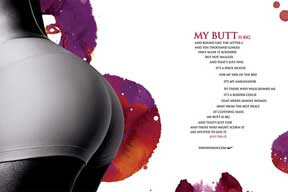Advertising: Sex Sells
Women represent somewhere between 35%-45% of the total number of athletes in the United States and yet there still seems to be a lack of respect and attention given to these dedicated athletes. In the advertisement industry women athletes have been selected to represent products based on their sexuality and appearance and not on their strength and ability. Athletes such as Anna Kournikova who have never won a major singles professional tennis championship are rewarded for their appearance. In 2001 she made 15 million on endorsement deals alone, right about the same time her tennis career was fading due to chronic injuries (CNNMoney.com). Kournikova became a poster pinup for adolescent (and adult) males across the country but not based on her tennis playing, instead for a sports bra advertising campaign.
 Is
it wrong for female athletes who are attractive to use their looks
for endorsement deals? Of course not, but the way in which the products
are marketed needs to be investigated. Denying women athletes the
choice to be used in an advertisement is not the issue here; it is
the idea that the woman has to have a sex appeal that distracts from
her achievements in order to sell a product. In order to gain income
to cover their expenses the Australian Women’s Olympic soccer team
created a $20 calendar that involved full frontal nudity shots of
some of the players (Newshouse
News Service). The players insisted that the calendar was created
with the intention of showing off a woman’s fit and toned body while
raising funds to support the team. It is a woman’s choice to sell
these sexual images but the effects it may have on the young girls
who idolize these sports stars should be considered.
Is
it wrong for female athletes who are attractive to use their looks
for endorsement deals? Of course not, but the way in which the products
are marketed needs to be investigated. Denying women athletes the
choice to be used in an advertisement is not the issue here; it is
the idea that the woman has to have a sex appeal that distracts from
her achievements in order to sell a product. In order to gain income
to cover their expenses the Australian Women’s Olympic soccer team
created a $20 calendar that involved full frontal nudity shots of
some of the players (Newshouse
News Service). The players insisted that the calendar was created
with the intention of showing off a woman’s fit and toned body while
raising funds to support the team. It is a woman’s choice to sell
these sexual images but the effects it may have on the young girls
who idolize these sports stars should be considered.
 Take
the Nike advertising campaign that showed "real women" for
example. The images were zoomed in on a woman's butt, shoulders, thighs,
and knees with little anecedotes next to the pictures. Nike was attempting
to move away from the highly controversial debate over using attractive
female athletes to market their products based on appearance alone,
which was the current trend in advertising. The images were meant
to highlight aspects of the female body that have become strong due
to physical activity, yet there still seems to be some sexualization,
especially for the image of the woman's butt.
Take
the Nike advertising campaign that showed "real women" for
example. The images were zoomed in on a woman's butt, shoulders, thighs,
and knees with little anecedotes next to the pictures. Nike was attempting
to move away from the highly controversial debate over using attractive
female athletes to market their products based on appearance alone,
which was the current trend in advertising. The images were meant
to highlight aspects of the female body that have become strong due
to physical activity, yet there still seems to be some sexualization,
especially for the image of the woman's butt.
The female body is amazing, and women athletes have perfected theirs through years of disciplined training but there is a certain level of disgrace to the sport in seeing an electronic device being sold by a half-naked athlete. For women to feel as though they have to take off their clothes and show some skin to get endorsement deals is a social problem and just shows another one of the ways in which women are sexualized and marketed. Until people can look past a female athlete’s appearance and focus on her ability and skill, the advertising market will continue to sell products attached to a pretty face. Although nudity and sex does draw attention and interest in these women it may not gain the respect or credibility that women’s sports so desperately need.